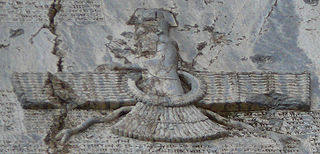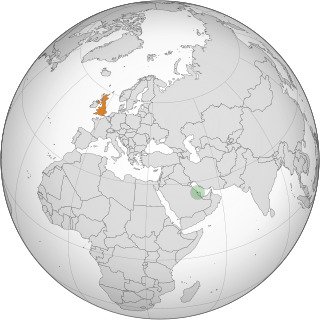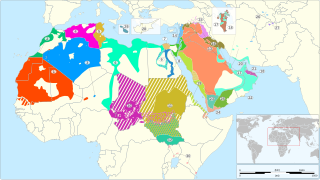
The Eastern Province, also known as the Eastern Region, is the easternmost of the 13 provinces of Saudi Arabia. It is the nation's largest province by area and the third most populous after the Riyadh and Mecca provinces. In 2017, the population was 4,900,325. Of these, 3,140,362 were Saudi citizens and 1,759,963 were foreign nationals The province accounts for 15.05% of the entire population of Saudi Arabia and is named for its geographical location relative to the rest of the kingdom.

Gulf Arabic is a variety of the Arabic language spoken in Eastern Arabia around the coasts of the Persian Gulf in Kuwait, Bahrain, Qatar, the United Arab Emirates, southern Iraq, eastern Saudi Arabia, northern Oman, and by some Iranian Arabs.

Islam is the state religion in Bahrain. Due to an influx of immigrants and guest workers from non-Muslim countries, such as India, the Philippines and Sri Lanka, the overall percentage of Muslims in the country has declined since the late 20th century. Bahrain's 2010 census indicated that 70.2% of the population is Muslim. The last official census (1941) to include sectarian identification reported 52% as Shia and 48 per cent as Sunni of the Muslim population.

Arab-Persians are people who are of mixed Arab and Persian ethnic, cultural, or national background, which is common in Iran, Iraq, Kuwait, Bahrain, and to a lesser extent, Lebanon and Syria.
Khuzestani Arabic is a dialect of Gelet (Southern) Mesopotamian Arabic spoken by the Iranian Arabs in Khuzestan Province of Iran. Whilst being a southern Mesopotamian Arabic dialect, it has many similarities with Gulf Arabic in neighbouring Kuwait. It has subsequently had a long history of contact with the Persian language, leading to several changes. The main changes are in word order, noun–noun and noun–adjective attribution constructions, definiteness marking, complement clauses, and discourse markers and connectors.

Greater Iran or Greater Persia, also known as Persosphere, is a sociocultural region in which Iranian traditions and Iranian languages have had a significant impact. It spans parts of West Asia, the Caucasus, Central Asia, South Asia, and parts of East Asia, specifically Xinjiang, China. The region is defined by having been long-ruled by the dynasties of various Iranian empires, under whom the local populaces gradually incorporated some degree of Iranian influence into their cultural and/or linguistic traditions; or alternatively as where a considerable number of Iranian peoples settled to still maintain communities who patronize their respective cultures, geographically corresponding to the areas surrounding the Iranian plateau. It is referred to as the "Iranian Cultural Continent" by Encyclopædia Iranica.
The Baharna are the indigenous Shia Muslim inhabitants of Bahrain. They inhabited the area even before the arrival of the Banu Utbah in the 18th century which the Bahraini royal family descends from. They are generally regarded by scholars and Bahraini people to be the original inhabitants of the Bahrain archipelago. Most Shi'i Bahraini citizens are Baharna. Regions with most of the population are in Eastern Arabia, with historical diaspora populations in Kuwait, United Arab Emirates, Qatar, Iraq, and Iran. Some Bahrainis historically immigrated to other parts of the world too.
The culture of Bahrain is part of the historical region of Eastern Arabia. Thus, Bahrain's culture is similar to that of its Arab neighbours in the Persian Gulf region. Bahrain is known for its cosmopolitanism, Bahraini citizens are very ethnically diverse. Though the state religion is Islam, the country is tolerant towards other religions: Catholic and Orthodox churches, Hindu temples as well as a (now-defunct) Jewish synagogue are present on the island.

Eastern Arabia (Bahrain), is a region stretched from Basra to Khasab along the Persian Gulf coast and included parts of modern-day Bahrain, Kuwait, Iraq, Eastern Saudi Arabia, United Arab Emirates, Qatar, Oman. The entire coastal strip of Eastern Arabia was known as "Bahrain" for a millennium.

The Ajam of Bahrain, also known as Persian Bahrainis or Iranian Bahrainis, are an ethnic group in Bahrain composed of Bahraini citizens of Iranian ancestry.
Bahrain is a nation in the Persian Gulf, in a strategical position in relation to the eastern coast of the Arabian Peninsula, Iran, Iraq and Oman.

There is a rich and ancient culture in Eastern Arabia. The culture in this region has always been oriented towards the sea.

Bahrain, officially the Kingdom of Bahrain, is an island country in West Asia. It is situated on the Persian Gulf, and comprises a small archipelago made up of 50 natural islands and an additional 33 artificial islands, centered on Bahrain Island which makes up around 83 per cent of the country's landmass. Bahrain is situated between Qatar and the northeastern coast of Saudi Arabia, to which it is connected by the King Fahd Causeway. The current population of Bahrain is 1,501,635 as of May 14, 2023, based on elaborations of the latest United Nations data, of whom 712,362 are Bahraini nationals. Bahrain spans some 760 square kilometres (290 sq mi), and is the third-smallest nation in Asia after the Maldives and Singapore. The capital and largest city is Manama.

Bilateral relations exist between Kingdom of Bahrain and the United Kingdom of Great Britain and Northern Ireland. Bahrain has an embassy in London and the United Kingdom is one of only four European countries to maintain an embassy in Manama. Bahrain gained independence from the United Kingdom in 1971 and has since maintained strong diplomatic, military and trade relations.

Varieties of Arabic are the linguistic systems that Arabic speakers speak natively. Arabic is a Semitic language within the Afroasiatic family that originated in the Arabian Peninsula. There are considerable variations from region to region, with degrees of mutual intelligibility that are often related to geographical distance and some that are mutually unintelligible. Many aspects of the variability attested to in these modern variants can be found in the ancient Arabic dialects in the peninsula. Likewise, many of the features that characterize the various modern variants can be attributed to the original settler dialects as well as local native languages and dialects. Some organizations, such as SIL International, consider these approximately 30 different varieties to be separate languages, while others, such as the Library of Congress, consider them all to be dialects of Arabic.

Peninsular Arabic are the varieties of Arabic spoken throughout the Arabian Peninsula. This includes the countries of Saudi Arabia, Yemen, Oman, United Arab Emirates, Kuwait, Bahrain, Qatar, Southern Iran, Southern Iraq and Jordan.
Jurdab is a village located in the Kingdom of Bahrain. It neighbors the villages of Jid Ali and Sanad and the 9th area in Isa Town, to the south of the capital Manama.
The administrative reforms of the 1920s were a series of British-led reforms that have laid the foundations of modern Bahrain. They took place between 1919 and 1927, but their background extends to the early 19th century. Britain signed a number of treaties with Bahrain in 1820, 1861, 1880 and 1892. The latter two had effectively turned Bahrain into a British Protectorate. Earlier in 1869, Britain had appointed the young Shaikh Isa ibn Ali Al Khalifa as ruler. Shaikh Isa was an autocrat and a feudal overlord whose authority was shared with his family and Sunni tribal allies. The economy was dependent on pearl diving and palm farming. Both sectors suffered from great inequalities; the conditions of the mostly Baharnah (Shia) peasants and the mostly non-Bahraini divers were often compared to slaves. Since the beginning of the 20th century, the British influence in Bahrain has been on the rise; in 1904-5 they extended their jurisdiction over all foreigners and in 1913 issued an Order in Council, which effectively turned Bahrain into a colony. The Order was not implemented until after the end of World War I.
Bahraini Gulf Arabic is a Gulf Arabic dialect spoken in Bahrain. It is spoken by Bahraini Sunni Arabs and is a dialect which is most similar to the urban dialect spoken in Qatar, the dialect spoken in Kuwait and Iraq.












